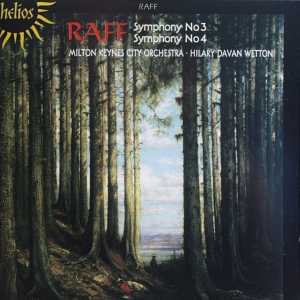|
Flights of imagination
ROBERT ANDERSON listens to Raff symphonies
|

|
It seems likely that no European Commission, however fuddled its thinking
or footling its actions, will get Raff (1822-82) back into copyright and
hence realise his boast that descendents could live imperially off is royalties.
They never did so, alas, but there is every chance that the omniumgatherum
policy of CD companies and the dawn of a new millennium conscious that its
own products will make Raff seem an indispensable immortal, may give him
a second wind. He deserves to be heard. There are half-a-dozen operas, eleven
symphonies and five concertos to be going on with, and there is no reason
why his future should depend on that thin thread of Raffishness we know
as the Cavatina for violin and piano, No 3 of the opus 85 Morceaux. Nearly
all the symphonies have titles, with nothing more arresting than the superscriptions
to No 6, 'Lived, Struggled, Suffered, Fought, Died, was Glorified'. Most
are concerned with such natural phenomena as forests, mountains, and the
seasons. He had a strange career that began in abject poverty and ended
with the directorship of the Frankfurt Conservatoire. Along the way he became
an accomplished contrapuntist and master of the orchestra.
It was his skill at scoring that took him to Weimar as a protegé
of Liszt. They had met in the most unlikely circumstances, when Raff sat
in an ever-increasing puddle of water on the platform at Liszt's side, having
walked from Zurich to Basel in a downpour to hear the great pianist. Liszt
was sufficiently impressed by his devotion and his compositions to find
him a job in Cologne. Then came the call to Weimar and a period in which
Liszt produced Raff's first opera, King Alfred, and Raff had a couple
of months in jail for unpaid debts. At the time Raff was a more experienced
orchestral composer than Liszt, and it was his task to fill out Liszt's
full-score suggestions with ideas that were ultimately to be corrected by
Liszt himself. Princess Carolyne saw the dangers: 'I may be stupid, but
it seems to me that this style, this dress, this clothing of the thought
to which you rightly attach such importance, always suffers if it is first
indicated or suggested by someone other than the genius who created the
work'. Raff came to exaggerate what he did for Liszt, but the essential
fact remains that at the end of their association there was not one master
of the orchestra, there were two.
 All the surviving Raff symphonies are post-Weimar, and there
is hardly a trace of Liszt in them. Formally, Raff sticks to classical models.
He likes variations, resourceful developments, and a good stirring of counterpoint.
Maybe there is a dash of Lisztian harmony; but mostly Raff is his own man,
with Mendelssohn as backup, notably in the Scherzo of No 3. He can produce
enchanting orchestral effects. The transition into the second tune of No
4, one of the nameless symphonies, is a case in point. . The obstinate rhythm
is given wing by the fine song of the cellos. Equally happy in No 3, Im
Walde, is the wood magic of the symphony's opening Allegro, when quiet
horns evoke the chatterbox activity of forest birds and creatures. The slow
movement of No 4 is a free set of variations on a theme that initially promises
as little as Beethoven's Diabelli snippet. First Raff conjures a ravishing
counterpoint on the bassoon, and this he follows up with a still more wonderful
flight of imagination for the oboe. All the surviving Raff symphonies are post-Weimar, and there
is hardly a trace of Liszt in them. Formally, Raff sticks to classical models.
He likes variations, resourceful developments, and a good stirring of counterpoint.
Maybe there is a dash of Lisztian harmony; but mostly Raff is his own man,
with Mendelssohn as backup, notably in the Scherzo of No 3. He can produce
enchanting orchestral effects. The transition into the second tune of No
4, one of the nameless symphonies, is a case in point. . The obstinate rhythm
is given wing by the fine song of the cellos. Equally happy in No 3, Im
Walde, is the wood magic of the symphony's opening Allegro, when quiet
horns evoke the chatterbox activity of forest birds and creatures. The slow
movement of No 4 is a free set of variations on a theme that initially promises
as little as Beethoven's Diabelli snippet. First Raff conjures a ravishing
counterpoint on the bassoon, and this he follows up with a still more wonderful
flight of imagination for the oboe.
The Milton Keynes City Orchestra has chosen to tread symphonic byways:
but the disc, with playing at once sensitive and alert under Hilary Davan
Wetton, suggests the team could commendably tackle anything that appeared
on their desks.
Copyright © Robert Anderson,
September 1st 1999
Joachim RAFF
Symphony No 4 in G minor Op 167
Symphony No 3 in F major Op 153 'Im Walde' / 'In the Forest'
The Milton Keynes City Orchestra
Diana Cummings, leader
Hilary Davan Wetton, conductor
helios (Hyperion) CDH 55017 DDD
TT: 79'11
Recorded on 30,31 October 1988
Recording Engineer: Anthony Howell
Recording Producer: Mark Brown
Cover Design: Terry Shannon
Booklet Editor: Ben Crighton
Executive Producers: Joanna Gamble, Kenneth Chaproniere
(P) Hyperion Records Ltd., London, 1993
(C) Hyperion Records Ltd., London, 1999
Originally released on Hyperion CDA 66626
Front illustration: The Forest (1856) by Gustave Doré
(1832-1883)
ORDER THIS CD FROM CROTCHET |
<< Music &
Vision homepage More CD reviews >>
|